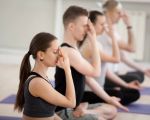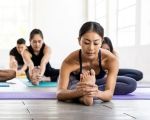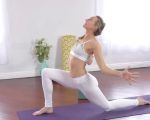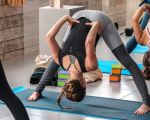- 1. Introduction: Why Yoga is Effective for Neck and Shoulder Tension
- 2. The Impact of Neck and Shoulder Stress on Your Health
- 3. Yoga Poses to Release Neck and Shoulder Tension
- 4. Breathing Techniques for Added Relief
- 5. How to Incorporate Yoga into Your Daily Routine
- 6. Personal Story: Finding Relief Through Yoga
- 7. Conclusion: Make Yoga a Regular Part of Your Stress-Relief Strategy
1. Introduction: Why Yoga is Effective for Neck and Shoulder Tension
Stress is an inevitable part of modern life, and its effects often show up in areas we least expect, particularly in our neck and shoulders. Tension in these areas can cause discomfort, limit mobility, and contribute to headaches, neck pain, and shoulder stiffness. For many people, these issues become chronic, affecting their daily life and overall well-being.
Yoga has become one of the most popular and effective ways to address stress and release built-up tension, especially in the neck and shoulders. Through targeted stretches, poses, and mindful breathing, yoga provides a holistic approach to relieving muscle tightness and improving flexibility. Whether you're new to yoga or an experienced practitioner, incorporating specific yoga poses into your routine can help ease the stress that builds up in these areas.
2. The Impact of Neck and Shoulder Stress on Your Health
Neck and shoulder stress is more than just a temporary discomfort—it can lead to significant long-term health issues if not addressed. Prolonged tension in these areas can result in chronic pain, reduced range of motion, and increased susceptibility to conditions such as poor posture, migraines, and even stress-related disorders like anxiety and insomnia.
When stress accumulates in the neck and shoulders, it can also affect the surrounding muscles and joints, leading to further strain. Over time, this can create a vicious cycle of pain and discomfort. The good news is that yoga offers effective tools to break this cycle and promote lasting relief.
By using specific yoga poses, you can target the areas where stress tends to accumulate and gradually release the tension. Yoga works by gently stretching and strengthening the muscles, increasing blood flow, and promoting deep relaxation. It also helps to counteract the effects of poor posture, which often contributes to neck and shoulder stress in the first place.
3. Yoga Poses to Release Neck and Shoulder Tension
There are several yoga poses specifically designed to relieve tension in the neck and shoulders. These poses help to stretch and strengthen the muscles, improve flexibility, and reduce stress. Here are some of the most effective yoga poses for neck and shoulder relief:
- Cat-Cow Pose (Marjaryasana-Bitilasana): This gentle flow between two poses helps to stretch the spine, neck, and shoulders while promoting fluid movement. Start on all fours, arch your back and lift your head (Cow Pose), then round your back and drop your head (Cat Pose). Repeat several times, focusing on the breath and the movement in your neck and shoulders.
- Thread the Needle Pose (Uttana Shishosana): This pose targets the upper back, shoulders, and neck. Begin in a tabletop position and slide one arm under your body, bringing your shoulder and ear to the floor. Hold for several breaths, then switch sides. This pose releases tension and helps open up the shoulders.
- Shoulder Shrugs and Rolls: While seated or standing, gently raise your shoulders toward your ears in a shrugging motion, then release them down. Afterward, roll your shoulders forward and backward in circular motions. This simple movement can relieve tightness and improve mobility in the shoulders.
- Seated Forward Fold (Paschimottanasana): Sitting with your legs extended in front of you, slowly hinge forward at the hips and reach for your feet or shins. This stretch targets the lower back, hamstrings, and shoulders, providing a full-body stretch while releasing tension in the neck and shoulders.
- Extended Child’s Pose (Utthita Balasana): Child's Pose is known for its ability to gently stretch the lower back, hips, and shoulders. By extending your arms forward in this pose, you can deepen the stretch in the shoulders and neck, helping to release any built-up tension in these areas.
Incorporating these poses into your daily practice can significantly reduce stress and improve the mobility of your neck and shoulders. Always listen to your body and avoid pushing beyond your limits during each stretch.
4. Breathing Techniques for Added Relief
Breathing plays a crucial role in yoga, especially when it comes to releasing tension. Deep, mindful breathing can help activate the parasympathetic nervous system, promoting relaxation and reducing stress. In addition to physical poses, incorporating specific breathing techniques can further enhance the benefits for your neck and shoulders.
- Diaphragmatic Breathing: Also known as deep belly breathing, this technique involves inhaling deeply through the nose, allowing your diaphragm to expand, and then exhaling fully. Practicing this breathing method while doing neck stretches helps to activate the relaxation response and release muscle tension.
- Nadi Shodhana (Alternate Nostril Breathing): This calming breathing technique involves inhaling and exhaling through alternate nostrils, helping to clear the mind and relieve stress. This can be especially beneficial before or after practicing neck and shoulder stretches.
- Ujjayi Breath: Often called "Ocean's Breath," Ujjayi involves a slight constriction of the throat, which creates a soothing sound while breathing in and out through the nose. This technique helps maintain a steady rhythm during yoga poses and provides an additional layer of relaxation during neck and shoulder stretches.
Pairing these breathing techniques with your yoga poses can deepen the relaxation process, releasing tension more effectively and promoting a sense of calm throughout your body.
5. How to Incorporate Yoga into Your Daily Routine
To experience the full benefits of yoga for stress relief, it’s essential to incorporate it into your daily routine. Regular practice helps build strength and flexibility, reduces stress, and prevents tension from accumulating in the neck and shoulders. Here are some tips for integrating yoga into your everyday life:
- Set a Routine: Try to practice yoga at the same time each day, whether it's in the morning, during lunch, or before bed. Consistency is key to improving flexibility and reducing tension.
- Short Sessions: If you’re pressed for time, even a short 10-15 minute yoga session can be effective. Focus on key poses like the ones mentioned earlier to relieve neck and shoulder tension.
- Incorporate Yoga at Work: If you spend long hours at a desk, take breaks throughout the day to do simple stretches like shoulder rolls, neck tilts, or seated forward folds to release tension in your neck and shoulders.
By making yoga a part of your daily routine, you can better manage stress and prevent neck and shoulder pain from becoming a chronic issue.
6. Personal Story: Finding Relief Through Yoga
Many people who experience neck and shoulder tension have found significant relief through yoga. For example, Sarah, a working professional who spent hours hunched over a computer, experienced chronic neck pain. After incorporating daily yoga poses and mindful breathing into her routine, she noticed a significant reduction in discomfort and improved mobility in her shoulders. By focusing on poses like Thread the Needle and Shoulder Shrugs, she was able to alleviate the tension that had been building up over time.
Sarah's story is just one example of how yoga can be a powerful tool in managing and relieving neck and shoulder stress. Regular practice not only helped her with physical relief but also provided mental relaxation, allowing her to approach her day with a clearer, calmer mind.
7. Conclusion: Make Yoga a Regular Part of Your Stress-Relief Strategy
Yoga offers an effective and natural solution for releasing stress in the neck and shoulders. By incorporating simple, targeted poses and mindful breathing techniques into your daily routine, you can reduce tension, improve flexibility, and promote overall well-being. Whether you're a beginner or an experienced yogi, there are numerous benefits to be gained from this holistic practice.
If you're looking to reduce stress and relieve neck and shoulder pain, start integrating yoga into your life today. For more information on yoga poses, tips, and products to support your practice, visit Free Yoga Links for helpful resources and recommendations.








